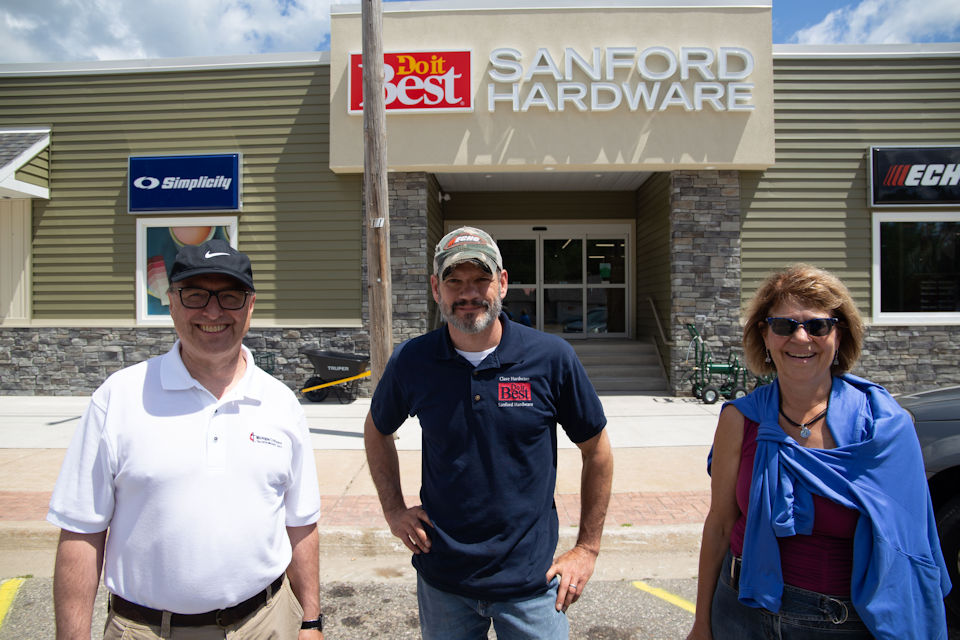Bishop David Bard and Michigan Conference leaders recently visited Sanford, Gladwin, and Midland to hear Case Managers talk about long-term recovery from the catastrophic Tittabawassee River flood in May 2020.
KAY DEMOSS
Senior Content Editor
A year after his first visit to flood-ravaged mid-Michigan, Bishop David Bard returned to the area on July 1, 2021, to learn first-hand about long-term disaster recovery efforts across the region. His visit began in Sanford, MI, then moved on to Gladwin and Midland, all places hard-hit when heavy rains overnight on May 19, 2020, caused two dams to fail along the Tittabawassee River.
By August of 2020, five Michigan Conference case managers were on the job, funded by UMCOR ($100,000), the Midland Area Community Foundation ($100,000), and Saginaw Community Foundation ($50,000). These advocates have been walking alongside homeowners ever since, and several were on hand July 1 to help the bishop and other conference leaders understand the scope of their work.
Case managers share
Carla Long serves as the Gladwin County Disaster Case Manager. She shared, “When you talk about the United Methodist Committee on Relief (UMCOR), the thing I appreciate the most is being able to look at the individual as a whole person, and not just at their disaster. … I seem to be in touch with those who are lost and forgotten about, so I am trying to make connections [for them] that will look out for them when we’re gone.”
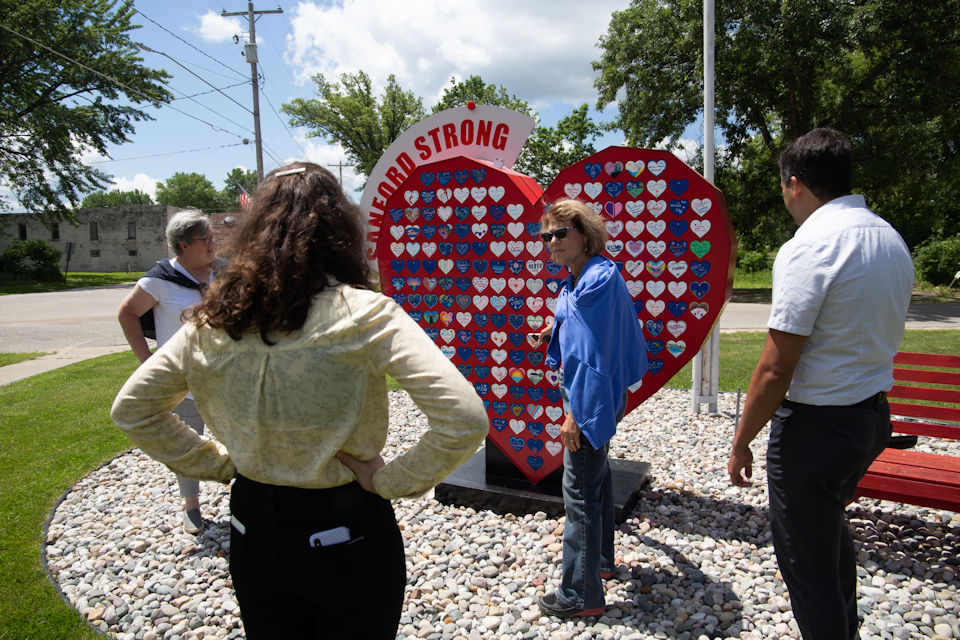
Raegan Schultz, Disaster Case Manager in Sanford/Midland, adds, “One thing that really stuck with me in our training was to think back at how the Lord has prepared each of us case managers for this exact point in our life. To show up for this role.” She adds that “We look at the experiences of the case managers and team together with our unique gifts … You can just really see the Lord’s hand in everything that we’re doing.”
Schultz, like Long, notes, “One thing we do in case management is to find those folks that have fallen through the cracks. For some reason, the systems in place aren’t working for them.” She told the story of her first client, a senior. “She never had a cell phone or a home phone. She didn’t have internet or a computer. She’s estranged from her family and had just left assisted living to move back into her home a week before the flooding.” The Red Cross gave her a cell phone, but she didn’t know how to use it. “This is an example of a client that needs case management because there are all these barriers in place, standing in the way of her being able to recover.”
Thanks to her case manager’s encouragement at the onset of winter, the woman moved from her camper into a motel. Today she is back home with the assistance of Habitat for Humanity. When asked, “What are you going to do now?” the woman answered, “I don’t know. I’m just going to live. I’m excited about my life.” Raegan concludes, “Case management empowers people and injects hope into their lives … She was a flood survivor who grew and became stronger after the flooding.”
Case Manager Long agrees. “Hope is probably the underlying theme with most people that we touch. We have brought hope to a point in their life when they felt so hopeless. And you have done nothing but listened.” Reflecting further on her work, Long remarks, “We listen and offer little steps. Sometimes it’s, ‘Let’s just do this.’ And then they start to see the bigger picture.”
Others who help
That bigger picture includes many in the community who offer support in a variety of ways. Three pastors and several laypersons were part of the July 1 meeting/tour. They shared how their congregations have assisted.
The Rev. Lisa Kelley is the Sanford United Methodist Church pastor, arriving July 1, 2020, just six weeks after the flooding. She says, “I am somebody coming to the community new and trying to help people plug in. That’s been good and a blessing, and it’s also frustrating for different reasons.” On top of trying to get unfamiliar “working parts together,” there was COVID. “That probably threw more wrenches into the mix than needed to be,” she remarks. Nevertheless, she celebrates church members’ willingness to pitch in. “What I’ve seen is people who have wanted to help. Even if they weren’t able to connect with long-term recovery and UMCOR, these active people are doing really good work in the community.” As COVID eases, Pastor Lisa Kelley believes there will be more opportunities to serve.
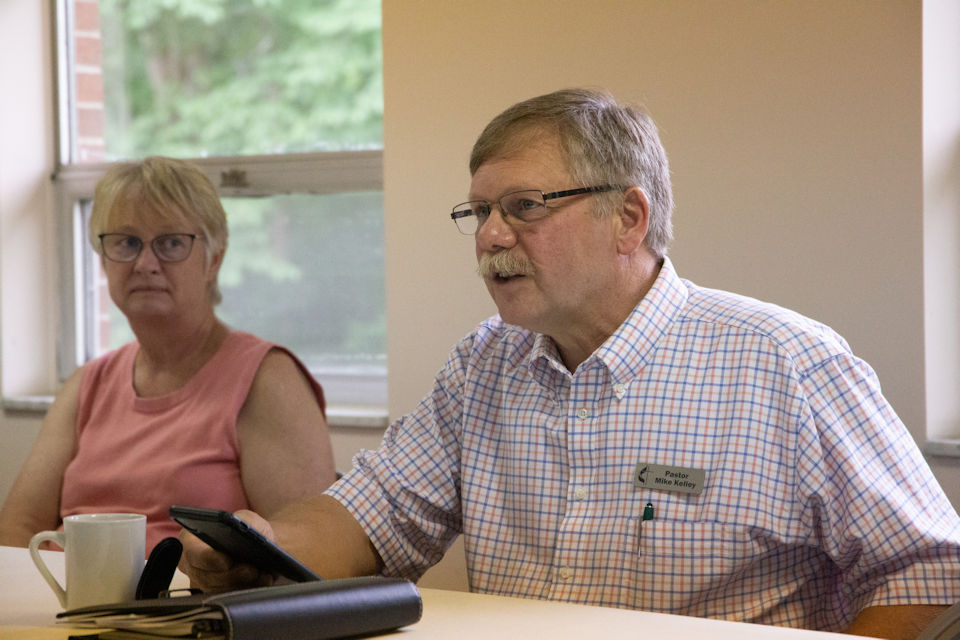
Sanford member Ruth Sutton “had five inches of water in her home; enough to create havoc.” However, Ruth is one of those people offering help to others. She has heard the stories of those suffering ten feet of water when she volunteers at the Flood Recovery Center. She remembers a woman who arrived needing cleaning supplies. “She was in tears,” Ruth recalls. “She said, ‘I’ve never, ever been in a position to have to ask for anything, and this has been so hard!’” Sutton also volunteers at The Open Door, the local homeless shelter that fed those living in motels after their homes were damaged. “At first, hundreds of people every day came needing three squares,” Ruth says. However, such food assistance is no longer needed. Instead, community resources like Meals on Wheels or Costco gift cards are being used to help feed those who continue to struggle.
She told the group another story that touched her heart. “Two days after the flood, I rode my bike downtown in Sanford and saw some people going through things on a vacant lot. I asked them what was going on because I didn’t know if they belonged there or not. I asked, ‘Where do you live?’ They said, ‘Well, we did live right here, but we can’t find our house.’”
The Rev. Mike Kelley, married to Pastor Lisa, serves in nearby Homer and Gordonville UMCs. He reports, “We were able to do some work starting with a couple of houses, but COVID backed that off. We look forward to being able to get back to restoring homes and people’s lives as part of the community here.”
Coleman Faith UMC’s pastor, the Rev. Scott Marsh, says, “Our church has been active in the relief process since the flood happened.” They distributed 100 Flood Buckets (Cleaning Kits) early on and mucked out houses. “We went for several weeks in the summer where we were doing something basically every day,” Marsh states.
In January of 2021, recognizing the need for long-term recovery, Coleman Faith ramped up their efforts. “We’ve had 656 hours logged, with 50 volunteers,” Marsh reports. “We are now north of 10 projects that we have been working on … Folks that haven’t gotten their houses put back together are often the forgotten ones in the area.” According to Marsh, when Faith volunteers work at one site, “sawing and cutting and doing whatever we’re doing,” others approach and request work at their home.
In addition to their labor, Coleman Faith has hosted flood benefit concerts, abiding with COVID restrictions, that raised money for UMCOR. In addition, several volunteer groups have found accommodation at Coleman Faith, with the help of Case Manager Long, who is a member of the congregation.
Personal stories
As the long-term recovery phase moves forward, there are still things to get done. Adam Sian is a member of Sanford UMC, whose home and family-owned hardware store were devastated in the flood. He shares, “We were not ‘ground zero zero’ but ground zero in Sanford. About 12-14 feet of water got rid of 20 years’ worth of work, just like that.” He and his family have been rebuilding for the past year. “I feel like I’m on the other side of this. I’m on the inside looking out,” Sian reflects. “I try to help where I can on the outside, but it never feels like you do enough.”
Sian described a local woman in her 60s struggling to live in the midst of devastation. “It’s hard to believe we’re, what, 14 months out from the flood. It just seems impossible that there are still people in that situation. It’s so much work, and resources are a double-whammy; super expensive right now.”
Sian is part of an informal group called “Sanford Builds” that’s addressing residential needs by redoing old houses. “We’ve got three or four properties we are currently working on,” he says. He is concerned for the overall health of the town. “One of the downsides of this flood is that now anything that was destroyed has to be brought up to new flood plans. You may spend over half of the building’s value doing that.” As a consequence, he believes, “many of the buildings that were ruined in the village are now either going to stay abandoned or not get much done to them.”
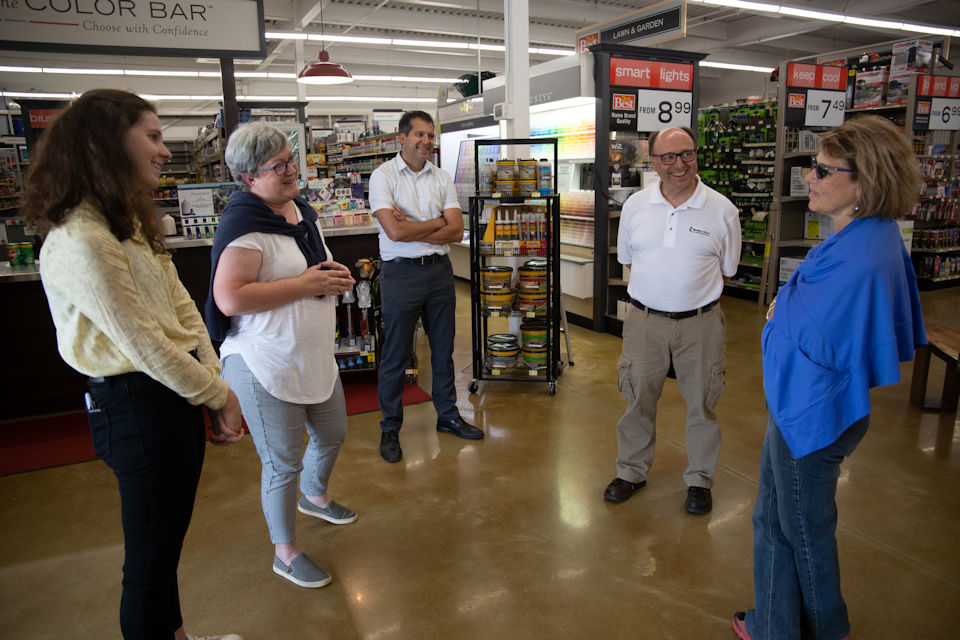
Sanford Trustee Becki Bastuk notes that the gas station is open, a new appliance store is coming, but there is uncertainty about whether the bank will build back. Bastuk has managed the group from Coleman Faith UMC as they clean and gut houses. She also “made sure that things happened” to make the Sanford parsonage ready for the arrival of the new pastor in July 2020.
Bill has lived for 32 years in a house beside a lake in Hope, MI. He thinks back to the night of May 19, 2020. “The storm came. We had rain for four days. It was just too much, and the dam couldn’t hold it back.” Bill did not evacuate but “went up the hill a little,” as two feet of water swamped his home. At 4 a.m., he and another person were “trying to save some stuff. But I lost titles to cars; you name it. We lost anything that was paper. Everything I owned was in here. It took five dump loads to haul the stuff away.”
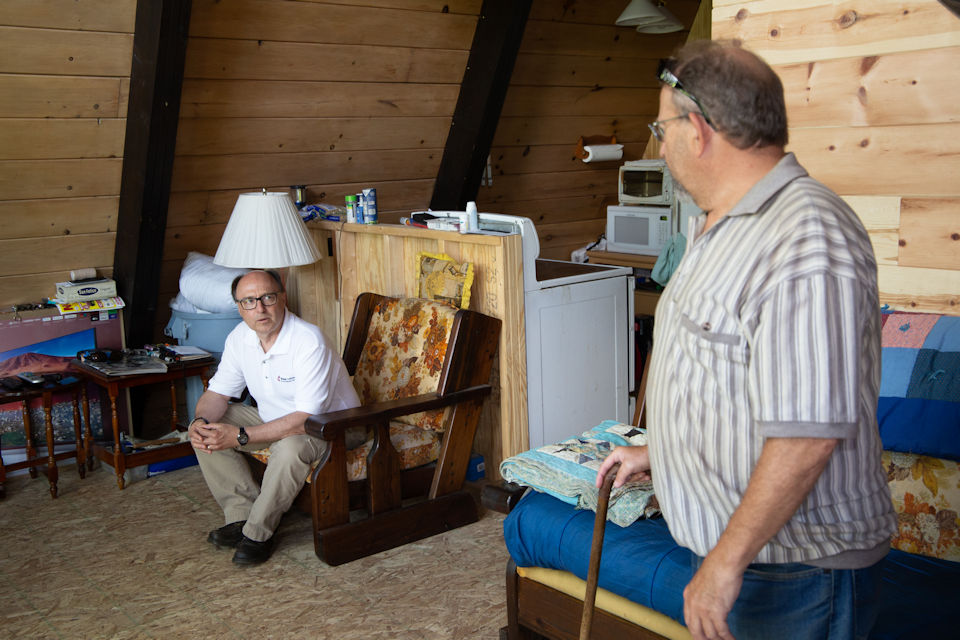
Today the repairs continue on Bill’s home. Electrical restored. Bathroom done. Countertops on the way. Insulation in. He moved back in November 2020 after six months in a trailer. He calls the FEMA process “Overwhelming. Then when Carla took over, it’s been absolutely fantastic.” Bill credits the Case Manager with securing maximum benefits for him. “It wasn’t until Carla came that we got anywhere. I would have given up. I bet I made a thousand phone calls,” Bill recounts.
Michigan Conference Case Manager Anne Wortley assists those in the Midland area. Eric is one of her clients. Wortley explains that the City of Midland condemned Eric’s house because the foundation shifted and there was water inside the home. “So, the family of three spent the entire year, from May 2020 to July 2021, in a fifth-wheel camper. … We offered them a rental unit or hotel, but this family doesn’t want to accept help. … The little furnace in the camper made it through the winter. … They’re like, ‘Anne, we’re fine. We’re okay; our furnace is still working. If our furnace gives out, I’ll let you know.’”
Eric got an EGLE permit that allows him to rebuild the current site, situated in the flood plain. According to Wortley, rebuilding could, with the high price of materials, cost $300,000. “His dad is a licensed builder, and Eric works for him. We will contract out furnace, plumbing, and electrical and are hoping to use in-kind materials that are available to bring the cost down,” Wortley says. She continues, “This is a great family that doesn’t ask for anything … But Eric knew he couldn’t come up with all this money on his own. So, he got the maximum grant from FEMA. They got approved for an SBA loan, and then we were able to contribute with our funding.”
Eric remarks, “I appreciate everyone’s help. Let me tell you, it’s hard to accept, but you have to do it. This taught me you have to accept help sometimes.” He shared his plans with the visitors. “Everything is finally starting to go. You know what I mean. Instead of the tear-down stuff, we’re starting to go the other way.”

Looking back 12 months, Eric talks about the rising water. “As soon as you see water in that field, it just starts creeping this way. We got my mom out of here about 8 pm that Tuesday night, once we realized it’s going to come.” While Eric and his father decided to stay on the site, they put his mother in a kayak and said, “Close your eyes. Dad and I are on each side. We can walk you to the corner.” When that plan proved too frightening, a neighbor took his mother to safety in a boat. By 7:30 am the next morning, Eric says, “I called and said, if you can get us out, I’d appreciate it. ‘Yeah, no problem.’ Forty-five minutes later, they brought a raft down here.” By then, the water was up to the knob on his door.
Resiliency and hope
How bad was it? ABC News quoted Midland City Manager Brad Kaye on May 20, 2020: “Flood heights are expected to be up to five feet higher than the last major flood in 1986. In 1986, it was considered a 100-year flood. The current flood is predicted to be the equivalent of a 500-year flood. That means a .002% chance (1 in 500) of it occurring in a given year, according to the U.S. Geological Survey.”
The Michigan Conference and UMCOR have been involved in the long-term recovery efforts since Eric, his family, and his neighbors experienced 24-hours of catastrophic weather and rampaging waters. Nancy Money served as The Michigan Conference Coordinator of Disaster Response Ministries at the time of the 500-year flood. She left that post earlier this year to become the Director of Community Impact for the United Way of Midland County. Money was present in Sanford for the July 1 tour and review. When asked how many families have been permanently displaced by the 2020 flood, Money answered. “Permanently? We’re hoping zero. Because the goal is to get them back in some stable housing. The Disaster Case Managers are involved in that now.”
While some lost their homes completely, like Eric, and others suffered significant damage, like Bill, Money says, “we are trying to get all back in either a rebuild or a rental or something else.”
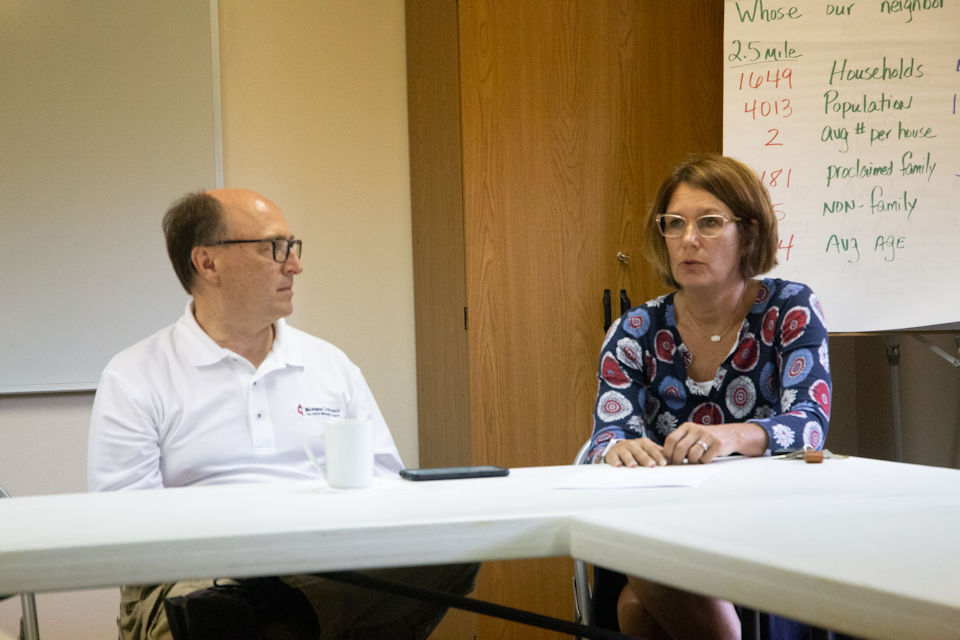
The question was asked during the morning sit-down in Sanford, “What is the message you would bring from mid-Michigan to Metro Detroit as they respond to recent flooding there? You’ve been there. What would you say to them?” Case Manager Carla Long answered. “When we were mucking out homes in the beginning here, Pastor Scott [Marsh] just let me deliver cleaning buckets because my heart was in connecting to people. Out of that experience, I would tell those in Detroit, ‘The listeners always need to be out there.’ More than getting work done, there needs to be someone who just listens.”
Case Manager Schultz agreed. “Telling their story is part of the grieving and the growing that enables moving forward.” Pastor Marsh added, “I think fixing hearts is one of those things we are doing, not just fixing homes.”
“The two words I would hold onto are hope and resiliency,” Money said. “I’ve seen these mid-Michigan communities twice in the last four years. I’ve seen homeowners go through this twice. And the fact that they still stand up and get up every morning and work hard and do what they can is just overwhelming to me.” (Read the account of the June 22, 2017 flood here.) She thanked those present for their dedication to the long-term recovery. “From the conference to the folks who are the boots on the ground, it takes everybody. It is amazing to see what’s been done in a year in this community,” Money stated.
Money also reported that FEMA has awarded their largest grant for this Region 5. “It’s a $3.4 million grant for case management services, construction oversight, and volunteer coordination over a two-year period.” The infrastructure and support systems in place in mid-Michigan for long-term recovery did not go unnoticed by FEMA. Not only will this grant increase the amount of help that can be given, “it allows case managers and construction managers to be flexible and work where there’s the greatest need,” Money explained.
In addition, a new $600,000 grant has been received from UMCOR for construction rebuilds in Arenac and Iosco counties. As a result, a sixth Disaster Case Manager is now at work in those areas where “a lot of people are still hurting.”
The Rev. Paul Perez, Director of Connectional Ministry for The Michigan Conference, was part of the group touring on July 1. He thanked Nancy Money for the groundwork she laid while on the Michigan Conference staff. “Nancy has a calling to disaster recovery ministry. So much of what has happened here is because of the gifts she’s brought to build that infrastructure of both organization and heart. It’s a team effort,” Perez noted.
The large stuff, like a multi-million dollar grant from FEMA, is essential to long-term disaster recovery. But Pastor Lisa Kelley reminded the group that there’s more. “Micah is Adam Sian’s little one. He ignores all COVID rules and hugs me every Sunday. He tells me he lost all of his Hot Wheel cars in the flood. That, to me, is where it hits home.” Micah’s father, Adam, replied, “It’s all small stuff.” Lisa emphasized, “But important stuff.”
Reflecting on his time in mid-Michigan, Bishop Bard said, “Visiting the flooded area in the Sanford/Midland area, I was impressed by the resilience of so many people in the face of tremendous loss. It was wonderful to see how people rallied to help each other, and I was very pleased with how our churches helped bring people together and simply helped.” He celebrated the work of Carla, Raegan, Anne, and their colleagues, saying, “I was also struck by how much work remains to be done a year after the flooding, and it is here that the United Methodist Committee on Relief continues to do remarkable work, making possible the hiring and deployment of case managers who are critical in helping people put their lives back together.”
But the long haul stretches on. “This kind of work does not often get a lot of publicity, but to those continuing to struggle with rebuilding their homes and their lives, this work matters profoundly,” the bishop concluded.
~ More photos can be found in Michigan Conference Flickr.
Last Updated on October 31, 2023

